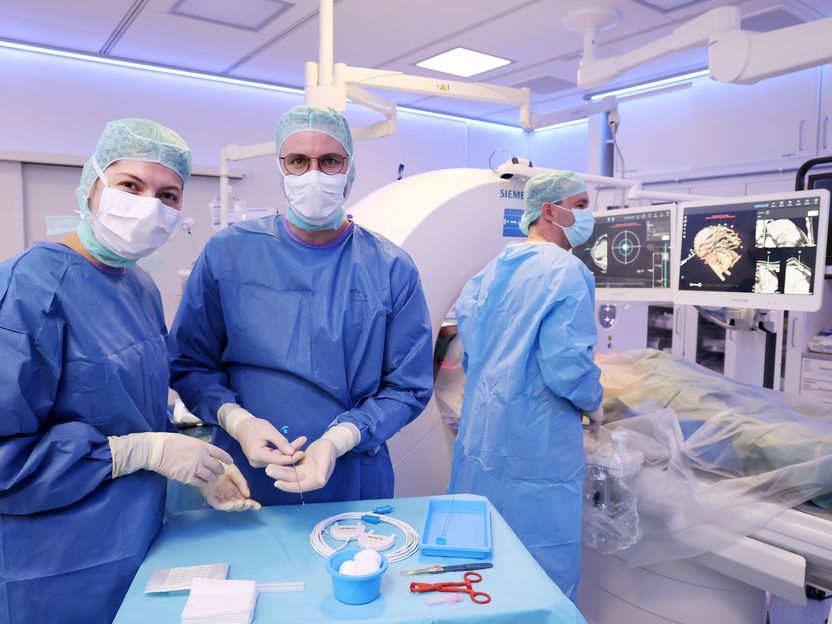Innovative treatment for liver tumors: Electrochemotherapy (ECT) at the University Hospital Regensburg
Advertisement
The University Hospital Regensburg (UKR) is setting new standards in the treatment of liver tumors: With electrochemotherapy (ECT), the Institute of Diagnostic Radiology at the UKR offers a promising, gentle and minimally invasive treatment option for patients with primary or secondary liver tumors.

Electrochemotherapy is a gentle treatment method for liver tumors. From left: Dr. Laura Kupke, Dr. Vinzenz Mayr, and PD Dr. Ingo Einspieler.
Vincent Schmuccker
In many cases, treatment of liver tumors is associated with considerable medical effort. Surgery is often necessary to remove the tumor. In addition to the psychological burden on cancer patients, there is also the physical burden of the operation. The aim is to gradually minimize this stress. The experts at the Institute of Diagnostic Radiology at the UKR are supported in this by electrochemotherapy (ECT). "Electrochemotherapy is a gentle alternative that protects the healthy tissue adjacent to or in the treatment area and at the same time enables effective tumor ablation," says PD Dr. Ingo Einspieler, Senior Consultant at the Institute of Diagnostic Radiology and Head of the Center for Radiological Interventional Oncology (RIO). Dr. Vinzenz Mayr, Senior Physician and Deputy Head of RIO, adds: "This procedure offers patients a low-risk treatment option that is particularly suitable for tumors that are difficult to access."
The innovative procedure combines the administration of a cytotoxic drug, usually bleomycin, with targeted electrical impulses. These impulses temporarily open the cell membranes of the tumor cells (electroporation), allowing the drug to penetrate the cells in significantly higher concentrations. The result is increased cytotoxicity, while the surrounding healthy tissue remains largely intact. ECT is particularly suitable for patients for whom surgical interventions are not possible or for tumors near sensitive structures such as blood vessels or bile ducts, where other ablation procedures such as radiofrequency or microwave ablation are not an option.
Tumors that are difficult to access can be treated more easily and gently
A significant technological innovation is the introduction of a bipolar electrode, which now makes it possible to ablate liver tumors via a single puncture site. Previously, at least three needles were required for this, which made the procedure more time-consuming and risky. The new bipolar electrode combines two poles in one needle, which simplifies treatment, reduces sources of error and increases safety. Small, difficult-to-access tumors in particular can be treated more efficiently and gently.
The UKR is already successfully using this gentle, non-thermal tumor ablation. The procedure is applied once and in low doses, which makes the treatment particularly well tolerated by patients. In contrast to other procedures such as radiofrequency or microwave ablation, one or two tumor foci in the liver can be treated in a targeted manner using AI-supported navigation without generating heat. The treatment is efficient, minimally invasive and is particularly suitable for patients in the early metastatic stage.
In order to determine the best possible treatment option for the individual patient, all cases are discussed in an interdisciplinary tumor board. There, experts from the various medical disciplines involved discuss each individual case and thus provide a therapy option.
With this innovative procedure and the associated innovative therapy, the UKR is taking a further step in the personalized and gentle treatment of liver tumours and underlining its role as a leading center for interventional oncology.
Note: This article has been translated using a computer system without human intervention. LUMITOS offers these automatic translations to present a wider range of current news. Since this article has been translated with automatic translation, it is possible that it contains errors in vocabulary, syntax or grammar. The original article in German can be found here.























































